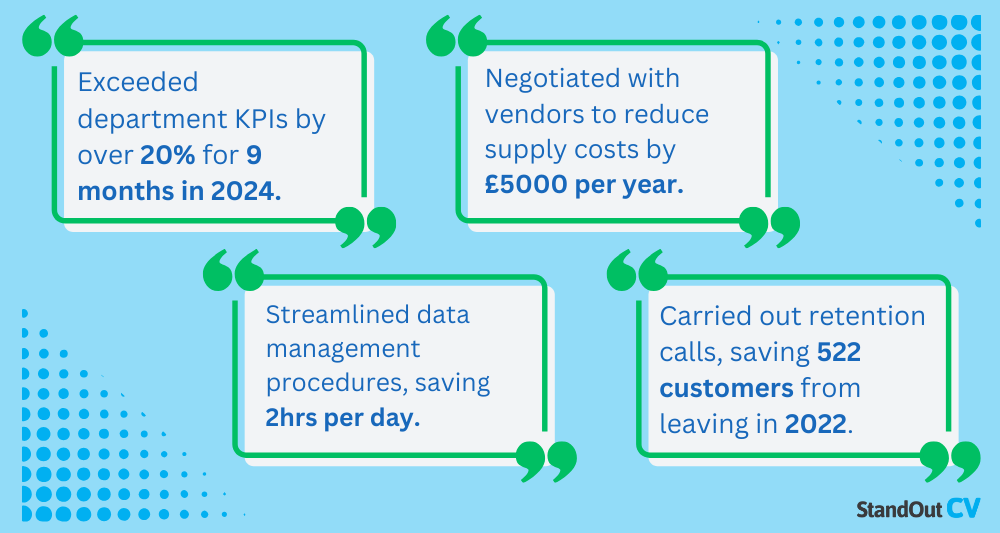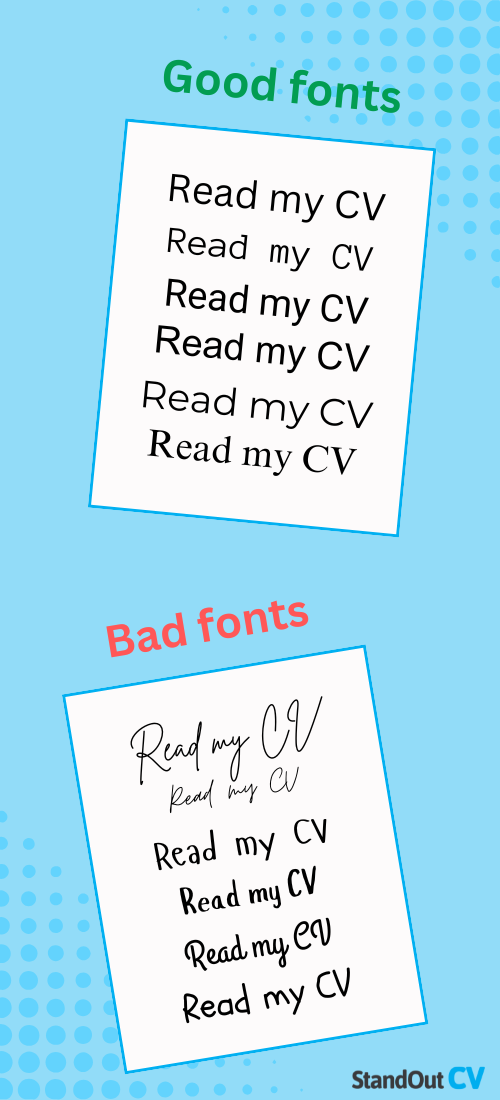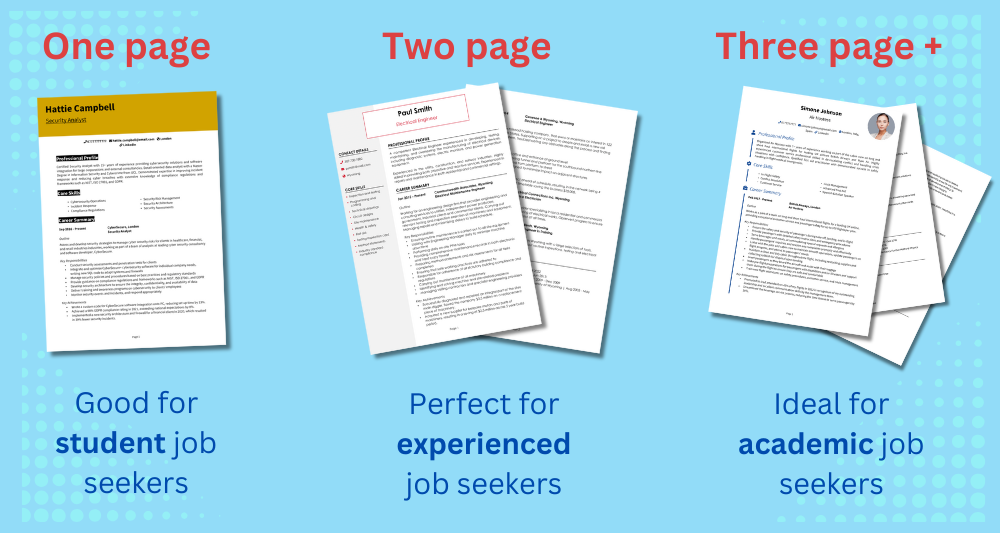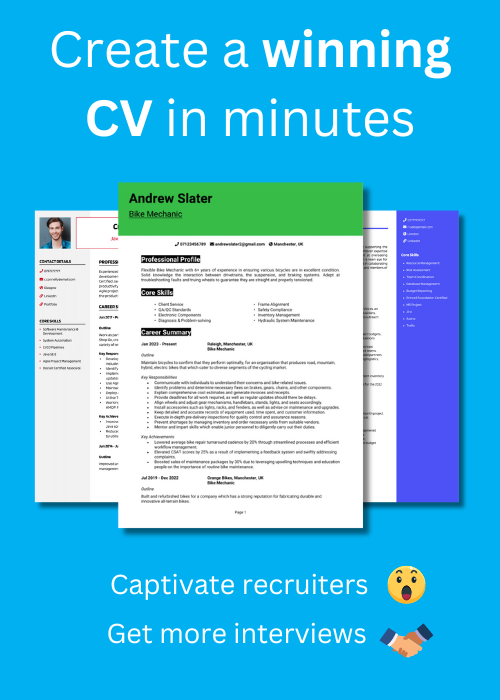The job market is more competitive than ever, with recruiters often receiving hundreds of applications for a single position.
If your CV looks just like everyone else’s, it risks getting overlooked before anyone even reads it.
This guide will show you 7 practical tips to make your CV stand out to catch more recruiters’ attention.
Use numbers to show your impact


Recruiters love to see numbers. They grab attention, break up text, and prove you’re not just making things up as you go. Instead of simply listing responsibilities, focus on the measurable, tangible impact of your work.
You should try to sprinkle numbers throughout multiple sections of your CV:
- In your personal profile – Instead of saying you have “experience in sales,” you should say, for example, “Sales professional with five years of experience who exceeded annual sales targets by 20%.” This makes your profile stronger and more specific.
- In your job responsibilities – Employers want to see what you actually achieved in your role. Rather than “Managed a sales team,” say, “Led a team of 10 sales representatives and increased regional revenue by 25% in one year” – the latter sounds much more legitimate.
- In your achievements – If you’ve had measurable success, write about it. “Reducing response times by 30%,” is much more memorable than just “Improving customer service processes.”
Not every job has easy-to-quantify results. But even if you weren’t single-handedly boosting revenue by 300%, you can still show impact – maybe you handled “high-volume customer inquiries” or “streamlined internal processes.”
Tailor your CV to the job


One of the biggest mistakes job hunters make is to ping off the same CV to each of the hundred jobs they apply for daily. Employers want to see why you’re the right fit for their role – not just any old job.
Start by carefully reading the job description and noting the key skills and qualifications the employer is looking for. Then, make sure your CV reflects those elements by:
- Matching key skills and terminology – If the job post emphasises “project management” and “budget oversight,” and you have experience in those areas, make sure those exact phrases appear in your CV – it’s the stuff recruiters are actively looking for!
- Highlighting your most relevant experience – You don’t need to list every job you’ve ever had. Focus on the roles that best demonstrate the skills required for the job you’re applying for, and briefly summarise or even drop really old and irrelevant roles.
- Customising your professional profile – Your CV profile should reflect the role you’re applying for, not just a generic career summary. If you’re applying for a digital marketing role, your profile should emphasise your experience with SEO, content creation, and analytics rather than just stating that you “work in marketing.”
Taking the time to personalise your CV will make the difference between being the right candidate or just another application in the pile.
Add a core skills section
You’ve just read that tailoring the skills you mention is important, but this bit is important enough to deserve its own point. Recruiters spend no more than 8 seconds looking at your CV, so a core skills section is essential to help them immediately spot your key strengths before they move on.
This section, typically placed just below your personal profile, should be a bullet-pointed list of six to ten key skills that are most relevant to the role. The best part? These are incredibly easy to swap out from one CV to another.
Keep it concise but impactful, focusing on hard skills which demonstrate industry-specific knowledge: a recruiter is actively looking for someone who can already use their complicated specialist software, not a “passionate team player”!
Make it easy to read


By now, you’ve probably got the impression that recruiters are pretty lazy. Well, you’re right. You should focus on making your CV format as easy and as pleasant a reading experience as humanly possible: if they struggle to even read it, they won’t bother trying.
Luckily, there are a number of simple tips you can follow to ensure employers can scan for the key details they need the most.
Use bullet points
No one wants to face a wall of text, especially recruiters. Use bullet points in every section of your CV to break up job responsibilities and achievements. Instead of listing duties in paragraph form, make your experience easy to digest by structuring it in short, focused points.
Divide your CV into clear sections
Recruiters should be able to quickly locate sections like work experience, education, and skills. Use bold section headings, keep spacing consistent, and ensure everything is easy to skim at a glance.
Choose the right font


Avoid fancy or overly decorative fonts that make your CV hard to read. Stick to professional, simple fonts in size 10pt to 13 pt for body text and slightly larger for section headings.
If you’re not sure which font works best for your industry, then look no further than this curated top 10 fonts list.
Keep it the right length


Unless you’re a professor with decades of research or a CEO with a portfolio of global takeovers, keep it to two pages max. Focus on including only the most relevant details and cut down anything that doesn’t add value.
Introduce yourself with a cover letter
Your CV lists your experience, but your cover letter is your chance to introduce yourself and make a real impression. Not only is it the first step in showing employers why you’re the right fit, it should motivate them to actually open your CV.
Keep it brief
Hiring managers don’t have time to read a lengthy essay, so your cover letter should get to the point quickly. Aim for just a few short paragraphs – it only has to be enough to persuade recruiters to check out your CV.
Start with a clear opening line that states the job you’re applying for and why you’re interested. Then, focus on what makes you a great fit. Avoid rehashing your entire CV – pick one or two key strengths that are most relevant to the job and showcase them in a way that adds value.


Be friendly and polite
Your cover letter should be professional, but that doesn’t mean it has to be stiff or robotic. Use a warm and natural tone, and address the hiring manager by name if possible. A simple “Dear Hiring Manager” is fine if you can’t find their name, but avoid the outdated “To Whom It May Concern.”
End your letter with a polite closing statement, thanking the employer for their time and consideration: building a personal connection will help your odds of landing any job, so you might as well start now.
Sell yourself
Your cover letter isn’t just about what you want from the job – it’s about what you can bring to the company. Instead of saying, “I am looking for an opportunity to grow,” focus on how your skills and experience will help the company succeed.
Frame your strengths in a way that directly benefits the employer. If you increased sales in your last role, explain how you would do the same for them. If you streamlined a process, show how you’ll continue that track record on their team. Employers want to know how hiring you will make their lives easier, so make it clear.
Include your LinkedIn profile or portfolio
If you’re not on LinkedIn, do you even exist in the professional world? Employers will look you up, so make sure they find something good. A LinkedIn profile or online portfolio provides a deeper look at your experience and helps reinforce your credibility.
- For corporate roles – A strong LinkedIn profile with recommendations, endorsements, and an updated work history can help validate your expertise.
- For creative and tech roles – A portfolio website, GitHub account, or Behance profile allows employers to see your work firsthand before you’re even hired.
Make sure your CV and LinkedIn profile are consistent and that any included links are up to date.
Use action verbs
Your choice of words can make a big difference in how engaging your CV is. Instead of passive descriptions, use action verbs to show how you took initiative and contributed to success.
Saying things like “Responsible for social media” is like saying “Responsible for breathing.” Okay, but what did you actually do? Try “Developed and executed a content strategy that increased engagement by 50%.”
As a bonus, using industry-specific keywords that match the job description to increase your chances of passing ATS screening, boosting your odds of being looked at by an actual human.



